When you begin to grow your marijuana plant indoors, it is then that you realize how important a grow light is for the development and well-being of your plants. When you grow your marijuana plants outdoors, you have the earth’s yellow sun acting as the source of light and heat for your plants. Indoors, however, you need to recreate the sun. Stop for a moment and think how cool it is – you recreate the sun in your basement! Not quite that, but it basically functions in that manner. The light that comes out of the grow lights has a similar effects on plants and allows them to grow in a better manner. This might leave some growers wondering – what if I leave my grow lights on 24 hours a day!
Well, you shouldn’t. Over the course of this article, we shall be taking a detailed look at what grow lights are, how they function, and most importantly, answer the question of “Can you leave grow lights on 24 hours a day?”.
Why is Light Important for Plants?
Light is very important for plants – as important as air and water (and perhaps even more). Plants need the sunlight for the process of photosynthesis where they convert the light into energy. Sunlight helps the plants create various kinds of sugars as ‘food’ which is then distributed to all their parts which helps them grow. In the absence of sunlight, this process won’t take place and the plants won’t grow. Genetically, sometimes you would find some plants growing towards the direction of the sun so that they get more and more sunlight and grow better. Parts of the plants with access to better sunlight show a better and more impressive growth than those on the bottom/hidden from light.
Talking about the marijuana plant, while going through different phases of growth, the marijuana plant needs different kinds of lighting and for different hours. Natural sunlight that we see is yellow or white in color and that is because it is a mixture of various different wavelengths of light, which include the red and the blue spectrum of lighting. We shall be taking a detailed look at what kind of light do plants need during different phases of their growth in a bit. However, let us first address our basic question:
Can You Leave Grow Lights on 24 Hours a Day?
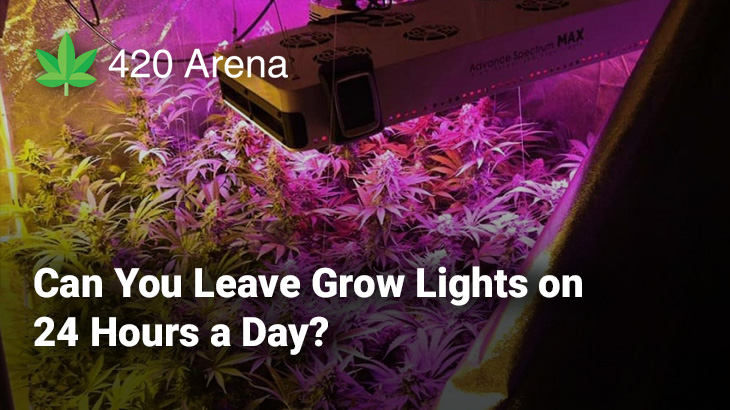
Well yes, you “can”, but you shouldn’t. This is because this will mean that you are putting the plants through too much stress as they are constantly photosynthesizing and producing food and energy but are not getting enough ‘rest’ hours to metabolize that energy. While the basic logic is that the more light your plants get the more foliage they will produce, it also means that plants go through a lot of stress and are not able to perform other functions. A minimum of 6 hours of darkness is recommended every day, regardless of which phase of growth your plants are in.
Sometimes providing continuous lighting to your plants for an extended period of time can even result in problems such as chlorosis and necrosis where your plant might die due to overexposure.
Are Dark (Non-Light) Hours Important for Plants?
As important as lighting is for plants, turning the lights off is also important. During the daytime, when the process of photosynthesis is happening, plants give out oxygen. At the night time, when there is darkness, plants stop the process and begin the process of metabolizing the energy. By nature, if you make the plants produce food 24×7, you are just putting undue stress on them and not giving them time to break down and consume the ‘food’ that they have prepared. Plants ‘rest’ during these hours.
Plants also perceive darkness as the onset of winter as that’s when the days get shorter. This triggers the reaction of blooming on some plants, including the marijuana plant. Let us now take a closer look at what kind of light does the marijuana plant need and how much lighting should you be providing it ideally:
Lighting During Different Phases
A marijuana plant goes through different phases of growth – the first two being the seed and the germination phase, where lighting doesn’t really matter much and no light is needed. However, from the seedling to the harvest phase, lighting is of importance. Let us take a closer look at how much light is needed during the different phases of growth of the marijuana plant:
- During the seedling phase, the marijuana plant requires maximum lighting. The plant is a tiny little plantling at this point of time and it needs as much sunlight as possible – and can handle upto 20-22 hours of lighting but with 2 to 4 hours of darkness. In this phase, you will need to provide the plant with the cooler ‘blue’ spectrum of lighting and this is the phase where you will witness the plant grow really rapidly.
- Following the seedling stage, as the plant matures into a taller and more well structured and branched entity, it will need a slightly lesser amount of lighting – down to about 18 hours, with 6 hours of darkness. Cooler blue shades of light work well in this phase too. In this phase, the stem begins to grow stronger and the foliage begins to get denser.
- After the vegetative phase of growth, the plant then moves to pre-flowering. You will know that you are entering pre-flowering when you see sex organs of the plant begin to get prominent and you will now be able to tell if you are growing a male or a female plant. Here, you will need the red spectrum of lights and you can reduce the lighting from 18 to about 16 hours a day.
- Flowering is the final and the most important phase of the plant’s growth. At this point in the plant’s growth, darkness is equally important as lighting. This is because plants will need about 12 hours of darkness and 12 hours of lighting. This triggers the plants into believing that winter is nearby which means this is the time to bloom flowers. Plants need the red spectrum of lights in this phase and the light needs to move closer to the plants than in the previous few stages.
What are the Different Types of Grow Light Options for Plants?
Plants have been growing indoors for several years and over the years we’ve seen a number of different innovations in the way lighting functions. Here, we take a closer look at some of the most common and popularly used forms of grow lights used by growers:
- Fluorescent Grow Lights: Popularly known as CFL lights, these grow lights produce low heat and come in two variants – daylight and warm white. The daylight variant gives out a cool spectrum of light which is good for the vegetative phase while the warm white variant is good for the flowering phase of the plant’s growth. These are decent enough and don’t cost too much too. They can fit into most common types of bulb holders. However, the problem with these lights is that their light output is too low when it comes to the intensity in comparison to other types of grow lights.
- High-Intensity Discharge Lighting: These come in two variants – High Pressure Sodium grow lights and Metal Halides. The former (HPS grow light) offers lighting which is more towards the warm (red) spectrum while the Metal Halides offer a cool (blue) spectrum of lighting. The latter can be used for the plants during their vegetative phase while the latter is good for the pre-flowering and flowering phase of the plant’s growth. HID lights offer quite an intense and bright light, and generally don’t cost too much. However, they consume quite a bit of electricity and disposing them off can be quite a task because of the presence of chemicals in the bulb. Another problem with HID lights is that they need a special ballast and a hood to function properly which adds on to the cost. They also tend to emit a lot of heat.
- LED Grow Lights: Last but certainly the most preferred lighting solution these days, LED grow lights help the growers ensure that their plants are getting the best possible lighting. LED grow lights consume the least electricity while offering the most intense and brightest output, while also lasting the longest. Some LED grow lights can last you over 100,000 hours! These lights also support full-spectrum lighting, meaning you do not have to change the light every time your plant moves from vegetative phase to flowering phase. Another huge benefit of using these grow lights is that they emit significantly lower heat compared to any other form of lighting and they are also non-toxic to dispose.
Frequently Asked Questions about Lighting for Plants
Here’s a collection of some of the most common and frequently asked questions (FAQs) about grow lights that growers tend to have. Do go through them as these answers will help clear up some of the most common confusions for you too!
1. Does more lighting mean more yield?
Yes, the more lighting you provide to your plants the more the foliage will be. However ‘yield’ is the sum total of everything that a plant goes through. You need to give it the right kind of lighting, humidity, nutrients, air flow, pruning, etc. to ensure that the yield is proper. Overexposing the plants with light might lead to the plants getting excessive stress and even dying in a worst-case scenario.
2. What happens if I turn the lights on 24/7?
The first effect that you will begin to notice is that your plants will become much greener and have a denser foliage in a rather short period of time. However, then you will notice that your plant needs more resources – more water, ventilation and nutrients. Then if you continue with this, there might be signs of stress and some parts of the plants will start dying out. Eventually there’s a chance that the growth gets stunted for an extended period – leading to the plant’s death.
3. Can I use the bulbs in my room’s lighting to grow plants?
Well technically, yes, you can. But should you? The light that comes out from these bulbs functions on a very narrow spectrum and won’t really be able to provide your plant with what it needs. You need a grow light which functions either on the red or the blue spectrum, or offers a full-spectrum lighting solution in order to grow your plants properly.
4. How to reduce the heat caused by grow lights?
Grow lights tend to generate heat, especially if you use something like an HID grow light. To ensure that the heat is properly dissipated, you need to ensure that your ventilation system is properly set up. Having a proper air flow makes sure the hot air stays out while a cool breeze is maintained inside. You might also need to use an air conditioner in case if you live in a really hot place.
5. Are grow lights legal?
Yes grow lights are legal as they are used to grow much more than marijuana – including vegetables like tomatoes and ornamental plants among other things! Growing weed might be illegal – and you must check with your local law authorities to ensure that you’re doing it all legally.
Conclusion
We hope that by this point in the article you have gained a better understanding of what grow lights are and why are they beneficial for your plants. You must not leave grow lights on 24 hours a day as that is counterproductive even in the short run! Give your plants about 20 to 12 hours of lighting depending on which phase of growth they are and make sure you’re providing them with the right spectrum and from the right distance to ensure healthy plants and maximum possible yield! If you have any other doubts about growing marijuana indoors, do let us know in the comments below and we shall get back to you soon. Alternatively, you can also drop us an email for the same. Til then….
…Happy Growing! 🙂
Table of Contents


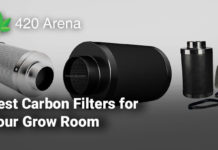
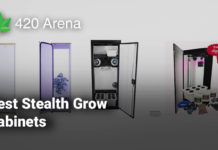
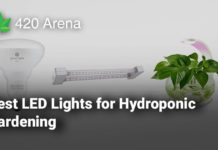




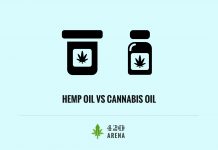



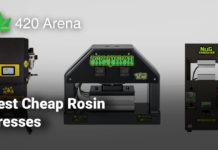
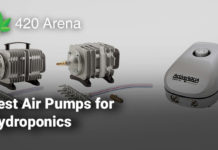
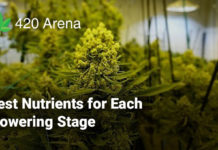
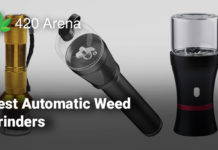
![How to Use Carbon Filters in Your Grow Room [7 Best Carbon Filters for Grow Rooms in 2021] How to Use Carbon Filters in Your Grow Room](https://420arena.com/wp-content/uploads/2020/12/How-to-Use-Carbon-Filters-in-Your-Grow-Room-218x150.jpg)





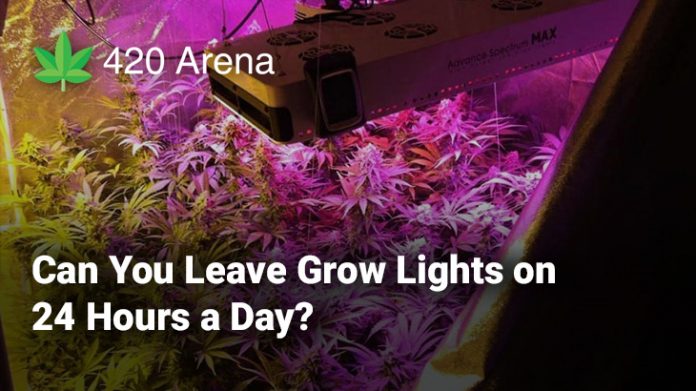

![How to Make a DIY Bubble Cloner [Complete Guide] How to Make a DIY Bubble Cloner](https://420arena.com/wp-content/uploads/2021/02/How-to-Make-a-DIY-Bubble-Cloner-218x150.jpg)





